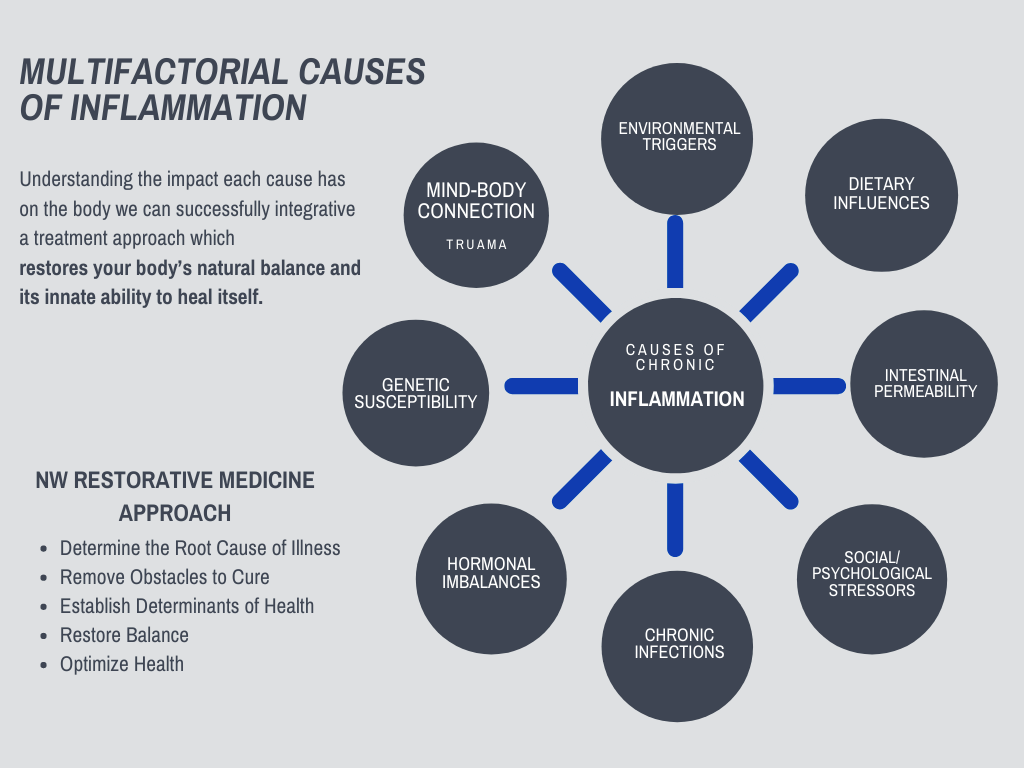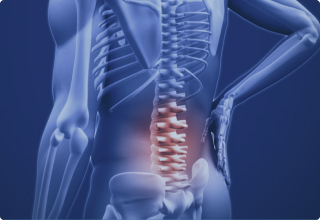Natural Low Back Pain Relief
Primary Reasons for Low Back Pain
- Injury to tendons and ligaments in the low back
- Sacroiliac joint dysfunction
- Muscle weakness
- Facet Arthritis
- Disc Pathology
Your Low Back is Connected to Your Whole Body, and so is Your Pain and Inflammation
As a result, the cause of low back pain and inflammation comes from many factors, requiring a whole-body approach to relieving pain.
Dr. Squires’ approach brings together a holistic treatment of all the factors contributing to your chronic inflammation and pain. Personalizing treatment to the factors most impacting your source of pain.
And combines it with a Regenerative Medicine approach that stimulates your own body’s healing response naturally.
Regenerative medicine is a cell-based therapy using advanced scientific techniques in the treatment of degenerative disease, orthopedic injuries, and joint conditions.
Discover how Dr. Squires can help by scheduling an initial consult »

Low Back Pain Conditions:
Symptoms of SI joint dysfunction can include:
- Pain in the lower back on one or both sides
- Sacroilitis – Sacroiliac joint inflammation and pain
- Sciatic Nerve Pain
- Pain is aggravated with prolonged sitting
- Pain is aggravated with extensive walking
Common Cause of Sacroiliac Joint (SI) Joint Dysfunction:
- Injury is one of the most common causes of sacroiliac (SI) joint pain.
- Traumatic injury often happens during a motor vehicle accident or hard fall.
- Injury can also result from chronic wear and tear from daily activities or sports with extreme bending and twisting leading to osteoarthritis.
- SI joint pain can also occur if a patient has undergone a lumbar fusion procedure.
- Low back pain and SI pain are often thought to be from disc pathology, however, it is much more common for a ligament injury in the area to be the source of pain. Ligament injury and instability can lead to disc pathology.
A thorough evaluation of all structures of the spine and pelvis as well as the stabilizing ligaments in the lumbar spine, pelvis, and sacrum is needed to truly determine the cause of low back pain and sacrum pain.
Treatments are usually conservative and consist of physical therapy, sacral belts, activity modification, nonsteroidal anti-inflammatory medications (NSAIDs), and cortisone (steroid) injections.
The problem with these treatments is that cortisone shots and anti-inflammatory drugs have been shown to yield temporary pain benefit, while long-term use results in loss of function and even more chronic pain by inhibiting the healing process of soft tissues and accelerating cartilage degeneration.
Regenerative Medicine for Sacroiliac Joint Dysfunction
Regenerative medicine addresses the root cause of weakened or damaged ligaments that contribute to sacroiliac joint instability leading to chronic inflammation and pain.
- Prolotherapy uses a dextrose based solution to create an inflammatory response recruiting fibroblast, growth factors, and even stem cells to an area of injury. In turn, this helps stimulate repair of tissues reinforcing connective tissue resulting in ligament/tendon strengthening and stability.
- Platelet-rich plasma (PRP) therapy involves using your own blood plasma and platelets as an enriched source of growth factors, immune cells, and collagen-building precursors to stimulate healing of bone and soft tissue. PRP is a more aggressive form of prolotherapy that places the growth factors and immune cells at the site of injury instead of the body needing to bring them to the site of injury.
- In a study comparing Platelet-Rich Plasma and Steroid injections it was found.
- Steroid injection reduced pain by 25%, while Platelet-Rich Plasma reduced pain by 90% at 3 months.
- The intra-articular PRP injection is an effective treatment modality in low back pain involving SIJ. (2)
Research Studies and References
- Freburger JK, Holmes GM, Agans RP, et al. The rising prevalence of chronic low back pain. Arch Intern Med. 2009;169(3):251‐258. doi:10.1001/archinternmed.2008.543
- Singla V, Batra YK, Bharti N, Goni VG, Marwaha N. Steroid vs. Platelet-Rich Plasma in Ultrasound-Guided Sacroiliac Joint Injection for Chronic Low Back Pain. Pain Pract. 2017;17(6):782‐791. doi:10.1111/papr.12526
Platelet-Rich Plasma Versus Corticosteroid Injection for Lumbar Spondylosis and Sacroiliac Arthropathy: A Systematic Review of Comparative Studies
- Ling JF, Wininger AE, Hirase T. Platelet-Rich Plasma Versus Corticosteroid Injection for Lumbar Spondylosis and Sacroiliac Arthropathy: A Systematic Review of Comparative Studies. Cureus. 2021 Mar 23;13(3):e14062. doi: 10.7759/cureus.14062. PMID: 33898145; PMCID: PMC8061754.
- Conclusion: Both PRP and corticosteroid injections are safe and effective options for the treatment of lumbar spondylosis and sacroiliac arthropathy. There is some evidence that PRP injection is a more effective option at long-term follow-up compared with corticosteroid injection. Further randomized controlled trials with longer-term follow-up are necessary to compare its long-term efficacy.
The iliolumbar ligaments are critical structures for stabilizing the lumbar vertebrae and sacrum. Trauma, injury, or chronic wear and tear to these ligaments causes weakness, instability, and pain. Weakness and instability progresses to degeneration, reduced mobility and increased pain.
- Thorough evaluation of all structures of the spine and pelvis as well as the stabilizing ligaments in the lumbar spine, pelvis, and sacrum is needed to truly determine the cause of low back pain.
- Low back pain is often thought to be from disc pathology, however, it is much more common for a ligament injury in the area to be the source of pain. Ligament injury and instability can lead to disc pathology.
- Slipped or herniated discs are often thought to be the cause of a pinched nerve causing radiating nerve pain. However, this is often the result of a ligament injury that allows for increased movement of the vertebrae causing instability leading to disc pathology.
Regenerative medicine addresses the root cause of weakened or damaged ligaments that contribute to instability leading to chronic inflammation and pain.
- Prolotherapy uses a dextrose based solution to create an inflammatory response recruiting fibroblast, growth factors, and even stem cells to an area of injury. In turn, this helps stimulate repair of tissues reinforcing connective tissue resulting in ligament/tendon strengthening and stability.
- Platelet-rich plasma (PRP) therapy involves using your own blood plasma and platelets as an enriched source of growth factors, immune cells, and collagen-building precursors to stimulate healing of bone and soft tissue. PRP is a more aggressive form of prolotherapy that places the growth factors and immune cells at the site of injury instead of the body bringing them to the site of injury.
Research Studies and References
Effect of platelet-rich plasma injections for chronic nonspecific low back pain: A randomized controlled study
- Won SJ, Kim DY, Kim JM. Effect of platelet-rich plasma injections for chronic nonspecific low back pain: A randomized controlled study. Medicine (Baltimore). 2022 Feb 25;101(8):e28935. doi: 10.1097/MD.0000000000028935. PMID: 35212300; PMCID: PMC8878905.
- Conclusions: In chronic nonspecific low back pain, the platelet-rich plasma injection in combination with prolotherapy is an effective intervention and either lidocaine or platelet-rich plasma injection significantly reduced disability. And injection at the lumbopelvic ligaments using the platelet-rich plasma and prolotherapy is also an effective treatment for pain.
Facet joints are one of the most common sources of low back pain. Facet joints are between joining vertebrae and are areas of constant motion during general movements. Facet Joints allow the spine to bend and twist. They also offer stability to the spine keeping it from moving too far forward or twisting too much. The amount of movement at the facet joints puts them at high risk for wear and tear or degenerative changes that lead to the development of osteoarthritis, reduced mobility, and increased back pain.
Regenerative Medicine for Facet Arthritis
Regenerative medicine injections stimulate the body’s natural immune response, an inflammatory response, encouraging growth factors and immune cells to the injured area to promote healing and repair.
- Platelet-rich plasma (PRP) therapy involves using your own blood plasma and platelets as an enriched source of growth factors, immune cells, and collagen-building precursors to stimulate healing of bone and soft tissue. PRP also signals stem cells to direct them to the area of injury stimulating repair and regeneration. PRP is great for moderate osteoarthritis, and cartilage lesions.
- Autologous stem cell (from your own body) therapies using both mesenchymal stromal cells (MSCs) and hematopoietic stem cells have shown therapeutic potential for advanced osteoarthritis. In orthopedic injuries and degeneration, stem cells have the potential to signal for the repair of damaged tissue with possible regeneration of tissue. It is important to note that research is mixed in regard to whether regenerative medicine truly regenerates tissue. What does seem to be more reproducible is a decrease in further degenerative changes, pain, and improved function.
Research Studies and References
A Prospective Study Comparing Platelet-Rich Plasma and Local Anesthetic (LA)/Corticosteroid in Intra-Articular Injection for the Treatment of Lumbar Facet Joint Syndrome
- Wu J, Zhou J, Liu C, Zhang J, Xiong W, Lv Y, Liu R, Wang R, Du Z, Zhang G, Liu Q. A Prospective Study Comparing Platelet-Rich Plasma and Local Anesthetic (LA)/Corticosteroid in Intra-Articular Injection for the Treatment of Lumbar Facet Joint Syndrome. Pain Pract. 2017 Sep;17(7):914-924. doi: 10.1111/papr.12544. Epub 2017 Feb 22. PMID: 27989008.
- Conclusions: Both autologous PRP and LA/corticosteroid for intra-articular injection are effective, easy, and safe enough in the treatment of lumbar facet joint syndrome. However, autologous PRP is a superior treatment option for longer duration efficacy.
Effectiveness of Ultrasound-Guided Versus Fluoroscopy or Computed Tomography Scanning Guidance in Lumbar Facet Joint Injections in Adults With Facet Joint Syndrome: A Meta-Analysis of Controlled Trials
- Wu T, Zhao WH, Dong Y, Song HX, Li JH. Effectiveness of Ultrasound-Guided Versus Fluoroscopy or Computed Tomography Scanning Guidance in Lumbar Facet Joint Injections in Adults With Facet Joint Syndrome: A Meta-Analysis of Controlled Trials. Arch Phys Med Rehabil. 2016 Sep;97(9):1558-1563. doi: 10.1016/j.apmr.2015.11.013. Epub 2015 Dec 17. PMID: 26705882.
- Conclusions: This review suggested that no significant differences in pain and functional improvement were noted between the USG and CT-/fluoroscopy-guided techniques in facet joint injection. USG injection is feasible and minimizes exposure of radiation to patients and practitioners in the lumbar facet joint injection process.

